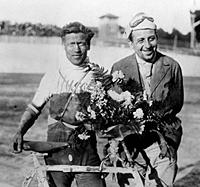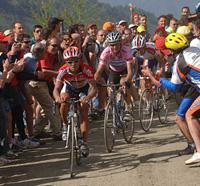
Recently on Cyclingnews.com |
Tales from the [cash-strapped] peloton, May 3, 2006
The paper and bike war that birthed the Giro
Like the Tour de France, the Giro was born out of the need for a struggling sport newspaper to build circulation. But there was also an element of bitter bike company rivalry, as Les Woodland relates.
Sweet and loveable person though you are, I bet once, just once, you've fallen out with your boss. And while you don't talk about these things, you've even taken a little revenge.

|
Well, you're not alone. Because that's how the Giro d'Italia got started.
"It was pretty easy to announce a Giro but the realities soon hit us, because we were broke."- Armando Cougnet, cycling editor of Gazzetta dello Sport, on the major challenge of running the first Giro. |
Angelo Gatti used to work for Bianchi, the bike people. Then bitterness boiled over into an arm-waving, throat-tearing row and he stormed off and started a rival company, called Atala. He went to the Bologna cycle show to sell his bikes and there he learned from a friend called Tomaselli that Bianchi was one of three partners in a venture to run the equivalent of the Tour de France in Italy. Bianchi would look after the cycling side, the Touring Club Italiano would do the organising based on its the round-Italy car rally, and the Corriere dello Sport newspaper would look after the cash and the publicity.
Happy to create mischief, Gatti slapped Tomaselli on the back and went off to see another friend, Tullo Morgagni, who was editor of a new daily sports paper, the Gazzetta dello Sport. Persuade Morgnani to run his own race and Gatti could upend Bianchi and Morgnani could upset the rival Corriere dello Sport.
The trouble was that in 1908 the Gazzetta was so short of cash that printers and journalists never knew if there'd be pay for them at the end of the week. That made the shock all the greater for Armando Cougnet, who edited the paper's cycling pages. He was on a business trip to Venice when he got a telegram: ABSOLUTELY ESSENTIAL FOR THE PAPER YOU ANNOUNCE IMMEDIATELY THE CYCLING TOUR OF ITALY. MORGNANI.

|
Imagine how Cougnet choked on his espresso. Essential? A race like the Tour de France? Me?
The best bit is that Morgnani hadn't even told the paper's owner, "Papa" Costamagna. He got the news, also by telegram, at his villa in Mondovi. The atmosphere when the three met at Gazzetta's offices at 2 via della Signora on August 6, the next day, was at the very least, er, mixed.
Morgagni started to explain. He told them about Gatti, about Bianchi, the Corriere and above all about the tiny circulation figures. Unless the Gazzetta did something big, it would be swamped by this new Giro and it would die before its 100th issue. The decision was driven by emotion and desperation. Within an hour, the three had concocted the announcement that appeared on August 7, 1908, in paper number 71: the Gazzetta dello Sport was going to organise a Giro d'Italia the following May.
Cougnet knew the technical side because he'd followed the Tour de France for two years. But he recalled, "It was pretty easy to announce a Giro but the realities soon hit us, because we were broke. Sometimes, we didn't even have money to pay the typesetters." The price worked out at 25,000 lire, which means nothing now and still less then, because however much it was, they didn't have it.
And then the fledgling organisers remembered a friend called Rossini. Rossini worked for a local bank and he explained that banks grew rich not with big sums but by collecting small amounts from a lot of people. He took a holiday from the bank and went literally knocking on doors to ask for money.
Maybe by this stage the rival Corriere was getting cold feet. It could see the Gazzetta had keenness if not cash and it put up 3,000 lire as first prize. That kept its name associated with cycling and it forced the cash-strapped Gazzetta to give publicity to its rival. Well, success breeds success and the Italian cycling association gave another 13,900 lire. Rossini got the remaining 8,000 from the Sghirla engineering company, the casino at San Remo, and elsewhere.
To the astonishment of nobody more than the journalists who'd dreamed up the idea, the first Giro started in the Piazza Loreto in Milan on May 13, 1909. The 127 starters signed on in the morning and at 2.53pm they set off for the first of 2,448km through Bologne, Chieti, Naples, Rome, Florence, Genes, Turin and Milan in eight stages.

|
It was an immediate success. Crowds lined the roads into Milan and soldiers had to escort the 49 riders who made it that far. "Standards flying in the wind on their galloping mounts, the lancers joined the first finishers for the last kilometres," wrote La Gazzetta. "After Dario Beni's victory, vehicles of the fire brigade carried the competitors to The Arena, where the crowd carried Ganna in triumph."
As overall winner, Luigi Ganna won 5,325 lire, about enough in pre-Euro days to buy a Gazzetta and a coffee but at the time four times more than Gazzetta's editor got paid each year. And Angelo Gatti, whose bitterness with Bianchi had launched the whole thing, was even happier because Ganna was head of his Atala team.
La Gazzetta wrote: "A glorious event has been deeply inscribed in the annals of sport, to be repeated yearly with growing enthusiasm and love."
There was no maglia rosa for Ganna that day on the via Musocco in Milan. Pictures show him less than glamorous in his filthy jersey and stretched woollen shorts. It was the greatest win of his life, better even than fifth in the Tour de France the previous year. Next year he came third. He came third, too, in the Tour of Lombardy in 1905, 1906 and 1907 and second in 1910. He won Milan-San Remo in 1909, came second in 1908 and third in 1911.
And Gazzetta dello Sport? It ran the Giro up to 1988, when the race moved to a separate company called RCS Organizzazzioni Sportivi, in the same building as Gazzetta but separate from it. And Corriere della Sera? It's now such good friends with Gazzetta that, along with the Giro, it's part of the same company.
